Related Research Articles

Messier 83 or M83, also known as the Southern Pinwheel Galaxy and NGC 5236, is a barred spiral galaxy approximately 15 million light-years away in the constellation borders of Hydra and Centaurus. Nicolas-Louis de Lacaille discovered M83 on 23 February 1752 at the Cape of Good Hope. Charles Messier added it to his catalogue of nebulous objects in March 1781.
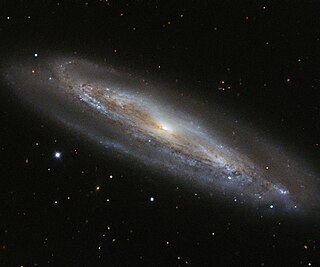
Messier 98, M98 or NGC 4192, is an intermediate spiral galaxy about 44.4 million light-years away in slightly northerly Coma Berenices, about 6° to the east of the bright star Denebola. It was discovered by French astronomer Pierre Méchain on 1781, along with nearby M99 and M100, and was catalogued by compatriot Charles Messier 29 days later in his Catalogue des Nébuleuses & des amas d'Étoiles. It has a blueshift, denoting ignoring of its fast other movement, it is approaching at about 140 km/s.

NGC 2903 is an isolated barred spiral galaxy in the equatorial constellation of Leo, positioned about 1.5° due south of Lambda Leonis. It was discovered by German-born astronomer William Herschel, who cataloged it on November 16, 1784. He mistook it as a double nebula, as did subsequent observers, and it wasn't until the nineteenth century that the Third Earl of Rosse resolved into a spiral form. J. L. E. Dreyer assigned it the identifiers 2903 and 2905 in his New General Catalogue; NGC 2905 now designates a luminous knot in the northeastern spiral arm.
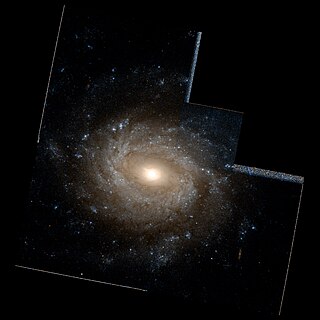
NGC 3486 is an intermediate barred spiral galaxy located about 27.4 million light years away in the constellation of Leo Minor. It has a morphological classification of SAB(r)c, which indicates it is a weakly barred spiral with an inner ring and loosely wound arms. This is a borderline, low-luminosity Seyfert galaxy with an active nucleus. However, no radio or X-ray emission has been detected from the core, and it may only have a small supermassive black hole with less than a million times the mass of the Sun.
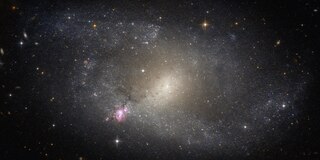
NGC 5398 is a barred spiral galaxy in the southern constellation of Centaurus. It was discovered June 3, 1836 by John Herschel. Distance estimates range from 5.39 Mpc to 18.30 Mpc. The tip of the red-giant branch method yields a distance of 11.6 Mpc, while the Tully–Fisher relation shows values of around 8.5 Mpc. It is receding with a heliocentric radial velocity of 1,219 km/s.

NGC 4319 is a face-on barred spiral galaxy located about 77 million light years away in the constellation Draco. The morphological classification is SB(r)ab, which indicates it is a barred spiral with an inner ring structure and moderate to tightly wound arms. It is situated in physical proximity to the galaxies NGC 4291 and NGC 4386, with X-ray emissions from the intervening gap indicating NGC 4319 and NGC 4291 may be interacting. NGC 4319 has a much higher proportion of ionized hydrogen compared to the Milky Way galaxy.

NGC 4536 is an intermediate spiral galaxy in the constellation Virgo located about 10° south of the midpoint of the Virgo cluster. However, it is not considered a member of the cluster. Rather, it is a member of the M61 Group of galaxies, which is a member of the Virgo II Groups, a series of galaxies and galaxy clusters strung out from the southern edge of the Virgo Supercluster. The morphological classification in the De Vaucouleurs system is SAB(rs)bc, which indicates it is a weakly barred spiral galaxy with a hint of an inner ring structure plus moderate to loosely wound arms. It does not have a classical bulge around the nucleus.

NGC 5364 is a grand design spiral galaxy located 54.5 million light years away in the constellation Virgo. It is inclined to the line of sight from the Earth at an angle of 47° along a position angle of 25°. It is a member of the NGC 5364 Group of galaxies, itself one of the Virgo III Groups strung out to the east of the Virgo Supercluster of galaxies.

NGC 3344 is a relatively isolated barred spiral galaxy located 22.5 million light years away in the constellation Leo Minor. This galaxy belongs to the group known as the Leo spur, which is a branch of the Virgo Supercluster. NGC 3344 has the morphological classification (R)SAB(r)bc, which indicates it is a weakly barred spiral galaxy that exhibits rings and moderate to loosely wound spiral arms. There is both an inner and outer ring, with the prominent arms radiating outward from the inner ring and the slightly elliptical bar being situated inside. At the center of the bar is an HII nucleus with an angular diameter of about 3″. NGC 3344 hosted supernova SN 2012fh, which was shown to likely be a Type Ib or Type Ic.

NGC 5755 is a barred spiral galaxy in the constellation Boötes, member of Arp 297 interacting galaxies group of four: NGC 5752, NGC 5753, NGC 5754, and NGC 5755.
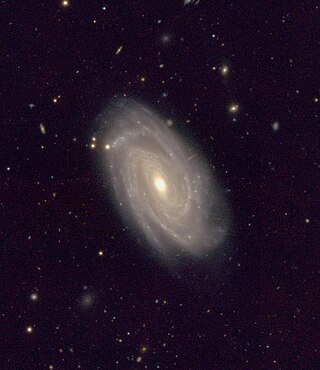
NGC 10 is a spiral galaxy located in the southern constellation of Sculptor. It was discovered by John Herschel on 25 September 1834. The galaxy is located at a distance of 346 Mly from the Sun. Its morphological classification in the De Vaucouleurs system is SAB(rs)bc, where the 'SAB' denotes a weak-barred spiral, '(rs)' indicates a slight ring-like structure, and 'bc' means the spiral arms are moderately to loosely wound. Paturel et al. (2003) assigned this galaxy a classification of SBbc, indicating a barred spiral galaxy.

NGC 925 is a barred spiral galaxy located about 30 million light-years away in the constellation Triangulum. The morphological classification of this galaxy is SB(s)d, indicating that it has a bar structure and loosely wound spiral arms with no ring. The spiral arm to the south is stronger than the northern arm, with the latter appearing flocculent and less coherent. The bar is offset from the center of the galaxy and is the site of star formation all along its length. Both of these morphological traits—a dominant spiral arm and the offset bar—are typically characteristics of a Magellanic spiral galaxy. The galaxy is inclined at an angle of 55° to the line of sight along a position angle of 102°.

NGC 2397 is a flocculent spiral galaxy located in the southern Volans constellation, about one degree to the SSE of Delta Volantis. English astronomer John Herschel discovered the galaxy on February 21, 1835. It is located at a distance of approximately 69 million light years from the Sun, and is a member of the small NGC 2442 group that includes NGC 2434.

NGC 3259 is a barred spiral galaxy located approximately 90 million light-years from Earth, in the Ursa Major constellation. It has the morphological classification SAB(rs)bc, which indicates that it is a spiral galaxy with a weak bar across the nucleus (SAB), an incomplete inner ring structure circling the bar (rs), and moderate to loosely wound spiral arms (bc). This galaxy is a known source of X-ray emission and it has an active galactic nucleus of the Seyfert 2 type.

NGC 6217 is a barred spiral galaxy located some 67 million light years away, in the constellation Ursa Minor. It can be located with a 10 cm (4 in) or larger telescope as an 11th magnitude object about 2.5° east-northeast of the star Zeta Ursae Minoris. The galaxy is inclined by an angle of 33° to the line of sight along a position angle of 162°.

NGC 6384 is an intermediate barred spiral galaxy located about 77 million light-years away in the northern part of the constellation Ophiuchus. It has a morphological classification of SAB(r)bc, indicating that it is a weakly barred galaxy (SAB) with an inner ring structure (r) orbiting the bar, and moderate to loosely wound spiral arms (bc). The galaxy is inclined by an angle of 47° to the line of sight, along a position angle of 40°. The estimated mass of the stars in this galaxy is 105 billion times the mass of the Sun.

NGC 1288 is an intermediate barred spiral galaxy located about 196 million light years away in the constellation Fornax. In the nineteenth century, English astronomer John Herschel described it as "very faint, large, round, very gradually little brighter middle." The morphological classification of SABc(rs) indicates weak bar structure across the nucleus (SAB), an incomplete inner ring orbiting outside the bar (rs), and the multiple spiral arms are moderately wound (c). The spiral arms branch at intervals of 120° at a radius of 30″ from the nucleus. The galaxy is most likely surrounded by a dark matter halo, giving it a mass-to-light ratio of 14 M☉/L☉.
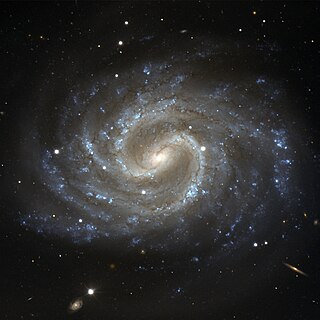
NGC 4535 is a barred spiral galaxy located some 54 million light years from Earth in the constellation Virgo. It is a member of the Virgo Cluster of galaxies and is located 4.3° from Messier 87. The galactic plane of NGC 4535 is inclined by an angle of 43° to the line of sight from the Earth. The morphological classification of NGC 4535 in the De Vaucouleurs system is SAB(s)c, which indicates a bar structure across the core (SAB), no ring (s), and loosely wound spiral arms (c). The inner part of the galaxy has two spiral arms, which branch into multiple arms further away. The small nucleus is of type HII, meaning the spectrum resembles that of an H II region.

NGC 4698 is a barred spiral galaxy located around 55 million light years away from Earth in the constellation of Virgo. It belongs to the Virgo Cluster of galaxies and is positioned near the northeastern edge of this assemblage. The morphological classification of NGC 4698 in the De Vaucouleurs system is SA(s)ab, which indicates a purely spiral structure with moderate to tightly wound arms. It is inclined to the line of sight from the Earth by an angle of 53° along a position angle of 170°.
ESO 603-G21 is a candidate polar-ring galaxy.
References
- 1 2 Skrutskie, Michael F.; Cutri, Roc M.; Stiening, Rae; Weinberg, Martin D.; Schneider, Stephen E.; Carpenter, John M.; Beichman, Charles A.; Capps, Richard W.; Chester, Thomas; Elias, Jonathan H.; Huchra, John P.; Liebert, James W.; Lonsdale, Carol J.; Monet, David G.; Price, Stephan; Seitzer, Patrick; Jarrett, Thomas H.; Kirkpatrick, J. Davy; Gizis, John E.; Howard, Elizabeth V.; Evans, Tracey E.; Fowler, John W.; Fullmer, Linda; Hurt, Robert L.; Light, Robert M.; Kopan, Eugene L.; Marsh, Kenneth A.; McCallon, Howard L.; Tam, Robert; Van Dyk, Schuyler D.; Wheelock, Sherry L. (1 February 2006). "The Two Micron All Sky Survey (2MASS)". The Astronomical Journal. 131 (2): 1163–1183. Bibcode:2006AJ....131.1163S. doi: 10.1086/498708 . ISSN 0004-6256. S2CID 18913331.
- 1 2 3 "ESO 235-58". SIMBAD . Centre de données astronomiques de Strasbourg . Retrieved 2019-11-01.
- 1 2 Iodice, E.; Arnaboldi, M.; Sparke, L. S.; Buta, R.; Freeman, K. C.; Capaccioli, M. (2004). "Photometric structure of the peculiar galaxy ESO 235-G58". Astronomy & Astrophysics. 418: 41–52. arXiv: astro-ph/0402126 . Bibcode:2004A&A...418...41I. doi:10.1051/0004-6361:20034012. S2CID 14877475.
- ↑ Buta, R.; Crocker, D. A. (1993). "The strange 'barred' spiral galaxy ESO 235-58 - A case of morphological deception". The Astronomical Journal. 106 (3): 939–947. Bibcode:1993AJ....106..939B. doi: 10.1086/116695 .
- ↑ Buta, R.; Crocker, D. (1992). "ESO 235-58: a new polar-ring-related interacting galaxy". Bulletin of the Astronomical Society. 24 (4): 1122–1123. Bibcode:1992BAAS...24S1122B.
- ↑ Buta, R. (2001). "Galaxies: Classification" (PDF). Archived copy. doi:10.1888/0333750888/1666. ISBN 0333750888. Archived from the original (PDF) on 13 September 2012. Retrieved 8 November 2018.
{{cite book}}:|work=ignored (help)CS1 maint: archived copy as title (link)